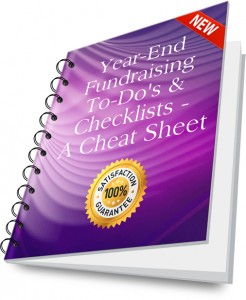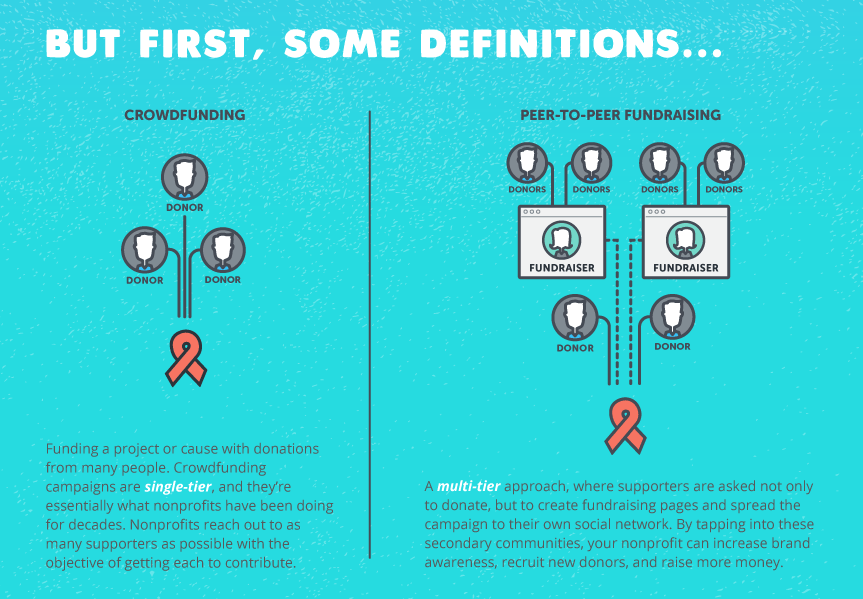Thinking about how to get more new donors this year? Wondering if you should purchase lists?
Consider this: Response to peer-to-peer fundraising is about 25% compared with direct-to-donor campaigns where response is 1 – 2%.
Why? People respond better to people than they do to organizations. Especially when it’s people they know and trust. When you hear about a cause from me, your beloved friend or respected colleague, this creates an emotional connection that predisposes you to pay attention. And even look upon my request with favor. Humans are hardwired to support their besties.
Now, add to that the fact that we’re living in the digitally revolutionized 21st Century.
You will recall that among the“Dive the Five” priorities I’ve encouraged you to embrace this year, one of them is online social fundraising.
According to Network for Good, 23% of all online giving is from peer-to-peer fundraising. The folks at Classy compiled data from several studies, and came up with an infographic that showed the impact of peer-to-peer social fundraising to be even higher.
That should be a BIG deal for your nonprofit’s consideration.
Besides the fact that people give more money to peers than organizations, there’s the fact that peer-to-peer fundraising puts your organization in touch with new donors at little to no cost.
The former Director of Digital at Charity: Water, Paul Young, described the value of peer-to-peer fundraising best in his post 5 Biggest Lessons From Leading Digital At Charity: Water:
The majority of charity marketing uses a direct-marketing model acquiring monthly givers. The goal is to convert a user into a direct donation, and ideally a monthly subscription. At charity: water, we focus on acquiring fundraisers because it is so much more valuable.
While our average donation size online is similar to most charities I have benchmarked, our average fundraising campaign is worth many times more. But even more importantly, every fundraising campaign brings in, on average, 13 new donors.
That should be a BIG deal for your nonprofit’s consideration.
So, with two big deals to consider…
Why Aren’t You Doing Peer-to-Peer Fundraising?
I find that relatively few nonprofits actively engage in peer-to-peer fundraising. If they do it at all, they do it as a little deal. A side project.
And I think I know why.
With the exception of face-to-face solicitation within the context of major gifts campaigns, nonprofits are not used to considering peer-to-peer fundraising as part of their core annual giving strategies.
Before the digital revolution, the traditional way of raising funds from individuals was direct mail. A letter written by one person (usually the Executive Director or Board Chair) sent to everyone on the mailing list. Most of whom were strangers.
In other words, the core of annual giving for many years has been direct-to-donor fundraising. In business marketing terminology, this is B to C (business to consumer).
Consumer to consumer (aka peer to peer) has not, until quite recently, been a go-to fundraising strategy or a considered “best practice.”
When I began in development work we didn’t even have computers, let alone the internet and social media. The only way to ask for non-major gifts (without going the face-to-face or phone route), was to write or type personal letters or notes. We could get those mass produced at the printers, but we couldn’t tailor them individually or easily send them from different volunteers.
So… we did as much peer-to-peer as we could, within the limits of our resources and technology. This sometimes meant printing letters and leaving the salutation and signature areas blank so volunteers could write their friends names in and send them out personally with their own signatures. Or it meant asking volunteers to add personal notes that we stuffed into the general appeal letter.
This worked well. However, it was a cumbersome and time-consuming process. So we didn’t reach a large percentage of prospective donors this way.
We did what we could. We only involved our board members and active donor-volunteers. We didn’t ask our broad base of members, donors and advocates to participate in peer-to-peer letter writing campaigns. It was just too difficult, and it didn’t make sense.
Peer-to-Peer Fundraising Makes Sense in a Digitally Revolutionized Landscape
Today, peer-to-peer online fundraising should be a no-brainer.
- It raises more money than direct-to-donor fundraising.
- It helps you reach a broader base of potential supporters by leveraging the power of your advocates and supporters’ online networks (email and social media) – whose combined mailing lists will be much larger than your organizational mailing list.
- It facilitates deeper donor engagement by offering a means to involve your supporters in addition to their monetary donation.
- It’s relatively easy to accomplish with off-the-shelf software.
- You can set it up to operate year-round.
IMPORTANT NOTE: This article distinguishes peer-to-peer fundraising from crowdfunding, which generally offers incentives for different tiers of donations to get a project up and running (and grew out of the likes of Kickstarter campaigns to seek venture capital for new businesses or raise money to pay medical expenses for a family member or friend). It’s similar, but often more of a one-shot deal. And it’s usually you asking for money rather than others asking for money on your behalf. The excerpted image below, from a terrific infographic created by the folks at Classy, illustrates the differences [click here to see the full Value of Peer-To-Peer Fundraising INFOGRAPHIC].
Peer-to-peer fundraising is direct, personal word of mouth – but delivered online.
The number one way people find out about a new brand today (yes, your nonprofit is a brand) is through word of mouth. People talk to their friends to get recommendations. For restaurants… movies… plumbers… car mechanics… and even charities!
The internet is like a giant water cooler, where all the good gossip and hottest trends are traded. When your peeps engage in peer-to-peer fundraising they are engaging in word-of-mouth recommending – telling their peeps that your nonprofit is the hottest cause out there.
Enable Trusted Word-of-Mouth Recommendations from Friends and Family Using Fundraising Pages
Your job as a fundraiser in today’s world is to facilitate philanthropy, enabling those who already love and support you to encourage their personal networks to join them as donors.
How you accomplish this is becoming easier with every passing day.
There are numerous companies who will build online, customizable fundraising pages for you (e.g., find a Top 15 Online Donation tools here; Mashable reviews 12 here). They’ll even integrate these pages with your social media accounts so folks can instantly spread the word about your campaign.
Spend some time choosing the fundraising site that works best for you. Look at their customizable options, support services (including training, coaching and promotion) and reports. They vary in fees and costs. Some are free, some have plans with monthly charges and some get their fees from your donations (much like a credit card company). Fees range between 3% and 8% of the funds you raise; some include credit card transaction fees, while others tack them on. Each site offers a different blend of services.
Create an Endless Cycle of Peer-Driven Support
Once systems are in place, you can reasonably oversee peer-to-peer fundraising with minimal disruption to your existing workload.
What’s exciting about this is that it becomes as simple as switching the “ON” button.
You set up the campaign, and then provide your donors with the tools they need to raise money themselves. This group of donor-advocates then passes on the same tools and knowledge to members of their personal networks, creating an endless cycle that exponentially increases your pool of supporters.
You can turn the button on or off at any point in time, depending on what other campaigns you have going on. Some charities, have it always turned “on” and they showcase the functionality on their website. Charity: Water facilitates this with birthday campaigns. They’re not the only ones (see here and here). Of course, you can also do simple one-time campaigns.
Set up Your Peer-to-Peer Campaign
Once you’ve selected an online vendor, you’re ready to build your campaign.
First, determine what type of campaign you’ll launch.
Will it be a one-time event that you spearhead and organize? This could be attached to an actual event, where folks take on personal challenges they pledge to complete (e.g., walkathons and special drives). It is also the kind of campaign you might run in conjunction with your annual campaign, or perhaps for a particular project that may be a subset of your campaign, asking your advocates to share your message via email or social media by providing them with copy and links.
My favorite peer-to-peer strategy right now is what’s being called a “DIY,” “self-directed,” or “rolling” campaign. You offer this as an ongoing fundraising opportunity right off of your website home page or main menu. As noted above, some organizations encourage supporters to set up their own “do-it-yourself” fundraising pages whenever the spirit moves them (e.g., birthdays, weddings, memorials). DIY self-directed campaigns increased 51% in 2015 per Donor Drive’s 2016 Peer-to-Peer Fundraising Report.
Next, identify your targets.
While you may believe everyone and their dog will care about your cause, it’s best to begin with those most likely to do so.
If you’re raising money for a particular project, pick folks you believe will care about that project based on what you know about their interests (i.e., what you’ve discerned from past surveys/research; what you know from past donations; what you know from past event attendance).
If you’re raising money for use where most needed, consider whether you want to target folks by:
- Age (e.g., Millennials, especially, and Boomers make the largest use of social media, which is one of the best ways to spread peer-to-peer campaigns)
- Geography
- Donation size and or giving likelihood (based on donor analytics or screening)
Next, take stock of your available resources.
Even though peer-to-peer fundraising is much more easily enabled than it was when I began in fundraising, it still takes work. It takes planning. And it takes resources.
- What staff/volunteer/infrastructure resources are available?
- What type of budget do you have?
- Where can you fit this into your work plan?
Reap the Many Benefits of Peer-to-Peer Fundraising
Like any other strategy, it’s essential to know your goals going in. If you don’t have clarity on what you want to accomplish, you’ll miss out on many of your potential benefits.
Peer-to-peer campaigns are not just about raising money. They’re also about:
- Reaching more people to increase the size of your donor base.
- Reaching people to whom you’d not otherwise have access.
- Engaging current supporters to build long-term loyalty and greater investment.
Enabling your supporters to help you in a way that doesn’t involve giving you money is a great way to engage them and build their loyalty over time.
They may have already made their most generous gift to you possible; that doesn’t mean they have to stop there! People seeking meaning in their lives (isn’t that almost everyone?) will generally welcome the opportunity to do another good deed. Raising money on your behalf fits the bill. It gives folks a sense of purpose, makes them responsible and just generally makes them feel good. If you properly reward them.
You have to close the loop with people to give them their well-deserved benefits and reap yours.
Consider what your P2P fundraisers do for you. Wow! They set up a page, put themselves on the line, and ask their networks to give money to you. They remind folks using email and social media. They do this mostly by themselves. It takes time, perseverance and guts. They should be rewarded.
As donors raise money for you, you have the opportunity to reach back and show your gratitude.
Plan for this in advance. What will you offer as a thank you? When will you offer it? Who will deliver it? How often will you report back on what your peerless peer-to-peer fundraisers accomplished on behalf of those served by your mission?
When you plan ahead to incorporate meaningful gratitude into your peer-to-peer fundraising initiatives, you make your donors and advocates feel really good about their participation. The cycle of gratitude that ensues ensures you’ll get the biggest bang for your efforts.
Your Peer-to-Peer Path Forward
As technology continues to advance, it will make it possible for you to do what could never have been envisioned previously. Even five years ago. To reach broader networks. To pinpoint the targets of your appeals. To reach out to prospects person-to-person. And to do so in a cost-effective manner that makes sense, even for small to medium-sized organizations.
- It’s time to stop rejecting innovative ideas, just because it’s never been your practice.
- It’s time to stop rejecting innovative ideas, just because you tried once, but it didn’t work then.
- It’s time to stop rejecting innovative ideas, just because you didn’t learn about them in a course or fundraising book.
Peer to peer fundraising delivers!
Take a good look at P2P for your nonprofit. Sure, it’s an investment. Sure you have to provide folks with a user-friendly tool, some support and a good reason for them to fundraise on your behalf. But it’s so much easier than it once was. And once you’ve got the infrastructure in place, you can sit back and let it take off.
Today is today. P2P fundraising is clearly becoming a “today” strategy. Carpe diem!
If you have experience with P2P fundraising, positive or negative, please share in the comments below. Thanks!
Get More Year-End Fundraising Tips!
 From mid November through December 31st many nonprofits will raise up to 40% of their total annual campaign goal. 33% of December gifts occur on the 31st of the month! Take a moment to assure you’ve got everything in place to make this is your best fundraising year ever. Year-End Fundraising To-Do’s and Checklists is what I call a “Cheat Sheet” — an all-in-one guide for ticking off the things you may be missing or may not quite have finished. Grab it here! As with all Clairification products, it comes with a 30-day no-questions-asked money back guarantee.
From mid November through December 31st many nonprofits will raise up to 40% of their total annual campaign goal. 33% of December gifts occur on the 31st of the month! Take a moment to assure you’ve got everything in place to make this is your best fundraising year ever. Year-End Fundraising To-Do’s and Checklists is what I call a “Cheat Sheet” — an all-in-one guide for ticking off the things you may be missing or may not quite have finished. Grab it here! As with all Clairification products, it comes with a 30-day no-questions-asked money back guarantee.
Related articles: How to Increase Your Fundraiser Proceeds with Peer-to-Peer Fundraising and Integrate Fundraising and Content for Nonprofit Survival.









Speaking as a recipient of a p2p email:
I get hit up too often by friends and relatives who want me to donate to their cause. Much as I like my friends and relatives, I would rather donate to causes that I support.